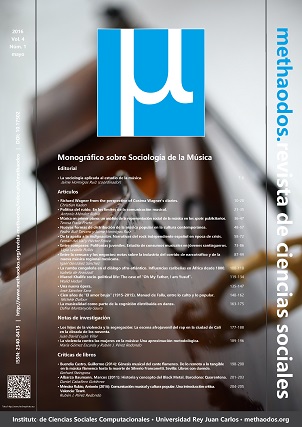The children of violence and segregation: The afrojuvenil rap scene in the city of Cali in the Nineties
Main Article Content
Abstract
This work seeks to demonstrate some pertinent connections between the contemporary ethnomusicology and the multiple lines of sociological research on urban Afro populations, from the partial investigation of the project Forms of Sociocultural Production of the African Youth Population in the Cali, City: The case of Caleño Rap in the Decade of the Nineties. For this purpose set out the main investigative reflections on the implications both social (Urrea and Quintín, 2000; Pratt, 2000a) as cultural of this phenomenon in the city (Waxer, 1997; Cuenca, 2001, 2008; Vélez, 2009) in addition, local rap music corpus, sociological studies of local violence towards African youths and the segregation lived in a Latin-American city about the ethnic population of musical rappers in Cali, Colombia at the end of the millennium.
Downloads
Article Details
References
Banfield, W. C. (2010): Cultural Codes: Makings of a Black Music Philosophy. An Interpretive History from Spirituals to Hip Hop. Lanham: Scarecrow.
Caldeira, T. (2010): Espacio, segregación y arte urbano en el Brasil. Buenos Aires-Barcelona: Katz-Centro de Cultura Contemporánea de Barcelona.
Charry, E. Ed. (2012): Hip Hop Africa: New African Music in a Globalizing World. Bloomington, Ind: Indiana University Press,
Cuenca, J. (2001): La construcción de identidades sociales en un grupo de raperos. Cali: Escuela de Sociología, Universidad del Valle. [Tesis de maestría].
— (2008): “Identidades sociales en jóvenes de sectores populares aproximaciones a un grupo de raperos”, Culturales, IV (007): 7-42.
Cross, I. (2008): “Musicality and the human capacity for culture”, Musicae Scientiae, 12 (1 suppl): 147–167. http://dx.doi.org/10.1177/1029864908012001071
Dennis, C. (2012): Afro-Colombian Hip-Hop: Globalization, Transcultural Music, and Ethnic Identities. Lanham, MD: Lexington Books.
Duranti, A. (2003): “Language as Culture in U.S. Anthropology; Three Paradigms”, Current Anthropology, 44 (3): 323-347. http://dx.doi.org/10.1086/368118
Farah, D. (1996): “Youth Use Rap to Urge End to Strife Born Out of Cali Cartel”, The Seattle Times. [01-10-2014] Disponible en web: http://community.seattletimes.nwsource.com/archive/?date=19961130&slug=2362376
Gans, H. J. (1979): “Symbolic ethnicity: the future of ethnic groups and cultures in America”, Ethnic and Racial Studies, 2 (1): 1-20. http://dx.doi.org/10.1080/01419870.1979.9993248
Guzmán, Á. (1999): “Violencia urbana y pobreza”, en Urrea, F. y Ortiz, C. H. Eds.: Patrones sociodemográficos, pobreza y mercado laboral en Cali: 45-56. Cali: Documento elaborado para el Banco Mundial.
Hennion, A. (2003): La pasión musical. Barcelona: Paidós.
Henriques, J. (2011): Sonic Bodies Reggae Sound Systems, Performance Techniques, and Ways of Knowing. New York: Continuum.
Informe de Organismos no Gubernamentales de Derechos Humanos (1996): A lo bien, Parce. Cali.
Koelsch, S. (2013): Brain and Music. Oxford, UK: Wiley-Blackwell.
Krims, A. (2007): Music and Urban Geography. New York: Routledge.
Labov, W. (1972): Sociolinguistic Patterns. Philadelphia: University of Pennsylvania Press.
Marabunta. (1998): “Presentación”, Editorial, 1: 4.
Mitchell, T. (2001): “Introduction. Another Root - Hip-hop Outside the USA”, en Mitchell, T. Ed.: Global Noise: Rap and Hip-hop Outside the USA: 1-38. Middletown, Connecticut: Wesleyan University Press.
Morgan, M. (2004): “Speech Community”, en Duranti, A. Ed.: A Companion to Linguistic Anthropology: 3-22. Malden, MA: Blackwell.
Pratt, T. (2000a): “The rap cartel and other tales from Colombia”, The UNESCO Courier: 38-39.
— (2000b): “The Rap Cartel, World Records, and Other Tales From Colombia”, Alternet. [01-10-2014] Disponible en web: http://www.alternet.org/story/9819/the_rap_cartel,_world_records_and_other_tales_from_colombia
Searle, J. (1992): Intencionalidad. Un ensayo en la filosofía de la mente. Madrid: Tecnos.
Universidad del Valle Televisión UV. TV. y Telepacífico. (1997): “Cali Rap Cartel. Poesía afilada”, Cali.
Urrea, F. y Ortiz, C. H. Eds. (1999): Patrones sociodemográficos, pobreza y mercado laboral en Cali. Cali: Documento elaborado para el Banco Mundial.
Urrea, F. y Quintín, P. (2000): Jóvenes negros de barriadas populares en Cali: entre masculinidades hegemónicas y marginales. Cali: CIDSE.
Vélez, A. (2009): “Construcción de subjetividad en jóvenes raperos y raperas: más allá de la experiencia mediática”, Revista Latinoamericana de Ciencias Sociales, Niñez y Juventud, 7 (1): 289-320.
Wade, P. (1999): “Working Culture. Making Cultural Identities in Cali, Colombia”, Current Anthropology, 40 (4), 449-471. http://dx.doi.org/10.2307/2991380
Waxer, L. (2003 [1997]): “Salsa, Champeta y Rap: los sonidos negros y las identidades negras en afrocolombia”, Boletín Música, 11-12: 19-30.
West, C. (2005): “Foreword”, en Darby, D. y Shelby, T. Eds.: Hip Hop and Philosophy: Rhyme 2 Reason. Chicago: Open Court.

